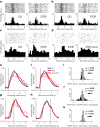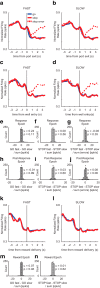Firing of Putative Dopamine Neurons in Ventral Tegmental Area Is Modulated by Probability of Success during Performance of a Stop-Change Task
- PMID: 29687078
- PMCID: PMC5909181
- DOI: 10.1523/ENEURO.0007-18.2018
Firing of Putative Dopamine Neurons in Ventral Tegmental Area Is Modulated by Probability of Success during Performance of a Stop-Change Task
Abstract
Response inhibition, the ability to refrain from unwanted actions, is an essential component of complex behavior and is often impaired across numerous neuropsychiatric disorders such as addiction, attention-deficit hyperactivity disorder (ADHD), schizophrenia, and obsessive-compulsive disorder. Accordingly, much research has been devoted to characterizing brain regions responsible for the regulation of response inhibition. The stop-signal task, a task in which animals are required to inhibit a prepotent response in the presence of a STOP cue, is one of the most well-studied tasks of response inhibition. While pharmacological evidence suggests that dopamine (DA) contributes to the regulation of response inhibition, what is exactly encoded by DA neurons during performance of response inhibition tasks is unknown. To address this issue, we recorded from single units in the ventral tegmental area (VTA), while rats performed a stop-change task. We found that putative DA neurons fired less and higher to cues and reward on STOP trials relative to GO trials, respectively, and that firing was reduced during errors. These results suggest that DA neurons in VTA encode the uncertainty associated with the probability of obtaining reward on difficult trials instead of the saliency associated with STOP cues or the need to resolve conflict between competing responses during response inhibition.
Keywords: conflict; dopamine; inhibition; neuron; rat; stop signal.
Figures







Similar articles
-
Neurons of the Ventral Tegmental Area Encode Individual Differences in Motivational "Wanting" for Reward Cues.J Neurosci. 2020 Nov 11;40(46):8951-8963. doi: 10.1523/JNEUROSCI.2947-19.2020. Epub 2020 Oct 12. J Neurosci. 2020. PMID: 33046552 Free PMC article.
-
Cue and Reward Evoked Dopamine Activity Is Necessary for Maintaining Learned Pavlovian Associations.J Neurosci. 2021 Jun 9;41(23):5004-5014. doi: 10.1523/JNEUROSCI.2744-20.2021. Epub 2021 Apr 22. J Neurosci. 2021. PMID: 33888609 Free PMC article.
-
Context-Dependent Multiplexing by Individual VTA Dopamine Neurons.J Neurosci. 2020 Sep 23;40(39):7489-7509. doi: 10.1523/JNEUROSCI.0502-20.2020. Epub 2020 Aug 28. J Neurosci. 2020. PMID: 32859713 Free PMC article.
-
VTA GABA Neurons at the Interface of Stress and Reward.Front Neural Circuits. 2019 Dec 5;13:78. doi: 10.3389/fncir.2019.00078. eCollection 2019. Front Neural Circuits. 2019. PMID: 31866835 Free PMC article. Review.
-
Expression of receptors for insulin and leptin in the ventral tegmental area/substantia nigra (VTA/SN) of the rat: Historical perspective.Brain Res. 2016 Aug 15;1645:68-70. doi: 10.1016/j.brainres.2015.12.041. Epub 2015 Dec 28. Brain Res. 2016. PMID: 26731335 Review.
Cited by
-
Neuroanatomical Changes in the Stopping Network Across the Adult Lifespan Assessed With Quantitative and Diffusion MRI.Hum Brain Mapp. 2025 Jun 1;46(8):e70240. doi: 10.1002/hbm.70240. Hum Brain Mapp. 2025. PMID: 40470689 Free PMC article.
-
Healthy aging in rats is associated with a decline in the ability to inhibit maladaptive responses, but not in measures of self-control by delayed gratification.Front Aging Neurosci. 2025 May 30;17:1579934. doi: 10.3389/fnagi.2025.1579934. eCollection 2025. Front Aging Neurosci. 2025. PMID: 40520538 Free PMC article.
-
Neural Signals in Red Nucleus during Reactive and Proactive Adjustments in Behavior.J Neurosci. 2020 Jun 10;40(24):4715-4726. doi: 10.1523/JNEUROSCI.2775-19.2020. Epub 2020 May 6. J Neurosci. 2020. PMID: 32376779 Free PMC article.
-
Medial prefrontal cortex lesions disrupt prepotent action selection signals in dorsomedial striatum.Curr Biol. 2022 Aug 8;32(15):3276-3287.e3. doi: 10.1016/j.cub.2022.06.025. Epub 2022 Jul 7. Curr Biol. 2022. PMID: 35803273 Free PMC article.
-
Multi-study fMRI outlooks on subcortical BOLD responses in the stop-signal paradigm.Elife. 2025 Jan 22;12:RP88652. doi: 10.7554/eLife.88652. Elife. 2025. PMID: 39841120 Free PMC article.
References
-
- Aron AR, Dowson JH, Sahakian BJ, Robbins TW (2003) Methylphenidate improves response inhibition in adults with attention-deficit/hyperactivity disorder. Biol Psychiatry 54:1465–1468. - PubMed
-
- Bedard AC, Ickowicz A, Logan GD, Hogg-Johnson S, Schachar R, Tannock R (2003) Selective inhibition in children with attention-deficit hyperactivity disorder off and on stimulant medication. J Abnorm Child Psychol 31:315–327. - PubMed
Publication types
MeSH terms
Grants and funding
LinkOut - more resources
Full Text Sources
Other Literature Sources
